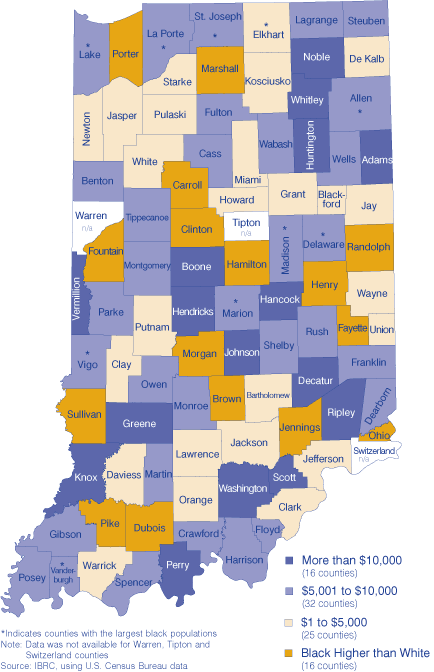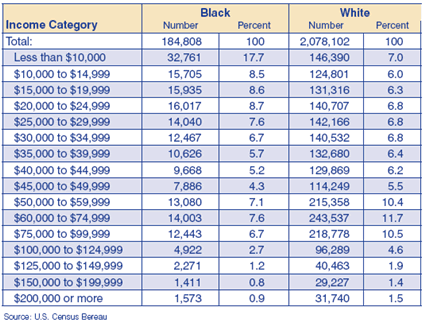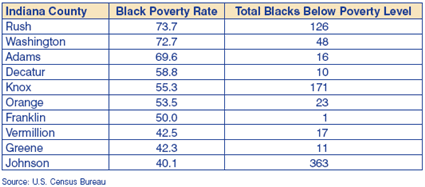Indiana's Income by Race
The tragedy of Katrina brought some broader societal issues to the surface, including the vast chasm between black and white income levels that continues to haunt this nation. The per capita income of a white person in Orleans Parish, La., was $31,971 while that same figure for a black person was a mere $11,332, according to Census 2000. One would think that Indiana communities would not have this severe gap dividing our communities into well-off whites and impoverished blacks like New Orleans and other areas in the deep south, but do the data support this assumption?
Undoubtedly, nowhere in Indiana has as high a concentration of African Americans as Orleans Parish, where 67 percent of the population is black. Lake and Marion counties lead the state at 25 percent and 24 percent, respectively. Table 1 shows some common income indicators for the ten counties with the most African Americans. Note: all calculations in this article are based on those classified as white alone or black alone and do not include those who indicated multiple races. Data is from Census 2000, unless otherwise noted.
Table 1: Indicators for Counties with the Largest Black Population, 2000
Per Capita Income
Statewide, per capita income for whites was $21,198, while blacks had an income of $15,049. In 16 counties, the per capita income for whites was more than $10,000 higher than it was for blacks (see Figure 1). Per capita income for whites ranged from $33,378 in Hamilton County to $16,036 in Crawford County. Meanwhile, that value for blacks ranged from $48,349 in Brown County to $1,688 in Ripley County (that county had only eight African Americans, all of whom were under 20 years old and only three were 15 or older). As in all of the county-level calculations, it is more likely for those counties with smaller black populations to fall at the high and low extremes because there are not as many people to compensate for outliers.
Figure 1: Difference Between White and Black Income, 2000

Household Income
Table 2 shows the distribution of income among black and white households statewide. Twenty-six percent of black households earned less than $15,000, compared to 13 percent of white households. At the other end of the spectrum, 1.6 percent of black households made over $150,000 per year, compared to 2.9 percent of white households.
Table 2: Indiana's Distribution of Household Income by Race, 2000

Indiana’s median income for those with a white head of household was $42,744. That figure fell to $29,164 for black households, a difference of $13,580. At the county level, these numbers can appear distorted where the concentrations of black households are relatively low. For example, Morgan County had a median household income of $47,791 for whites and $176,437 for blacks (no, that isn’t a typo). Of the 12 black households in Morgan County, nine earned between $150,000 and $200,000, while the other three households fell in the $45,000 to $50,000 range.
Poverty
Marion, Lake and Allen counties have the highest numbers of both whites and blacks in poverty (see Table 3). Those counties account for 21 percent of the impoverished whites statewide, but account for 73 percent of the African American population in poverty statewide. Marion County has about 5,700 more whites in poverty, although its rate was 12.5 percentage points lower than the black poverty rate. Lake County, by contrast, had close to 9,900 more blacks than whites in poverty and the gap in the poverty rates was just over 19 percentage points.
Table 3: Most People in Poverty, 2000

Poverty rates can mislead if taken at face value. Rush County shows a staggering 73.7 poverty rate among blacks (see Table 4). While not a pleasant statistic, this equates to only 126 people, and a small percentage of the overall number in poverty in the county.
Table 4: Highest Poverty Rates, 2000

Median Earnings
The most current data is from the 2004 American Community Survey, but it is only available for the state as a whole plus Lake and Marion counties. For Indiana, the median earning statistic for all whites was $26,482, while the comparable figure for African Americans was $20,673. Table 5 indicates that the racial gap in earnings is much more pronounced for men than for women (particularly in Lake County). It must be remembered that women are working from lower wage levels than their male counterparts to begin with; however, the gender gap appears to be more pronounced among white women than black women. Nevertheless, black women have the lowest median earnings across the board.
Table 5: Median Income By Gender for Those who Worked Year Round, Full-Time in the Last 12 Months, 2004

Click for larger image
Rachel Justis, Managing Editor
Indiana Business Research Center, Kelley School of Business, Indiana
University

